
 |
Previous | SkunkHaven.Net Index | Next |
Pet skunks are what an owner makes of them. Usually a skunk is settled into habits and has developed its own specific personality by the time it is 9 to 10 months old. Very well cared for skunks will be much more tolerant of owners, other pets, and strangers as well.
Skunks are wonderful when properly cared for and trained. We often get to see how poor diet, mistreatment, or general lack of knowledge and understanding affects a skunk. We rarely get the show quality, best temperament, lap-baby type skunks in as rescues. We'd like to show the bad side to let you be a better informed consumer and a better pet skunk owner. If you get a skunk you may have NONE of the problems, then again you may see all this and more.
One skunk or many? One skunk will require more direct quality time from an owner. Skunks enjoy playing with and lying around next to other living beings. Training a lone skunk can be more difficult, rewards are cheaper if there's only one contestant. It's also harder for one skunk to tolerate being home all day alone, that means the skunk will try to find something fun to occupy their time.
Two (or more) skunks are likely to pal around (once they know YOU are the boss and they don't need to argue about it), so you won't be required to be as involved with play and quality time. Training is easier with multiple skunks, they learn from each other, and they compete for those rewards. Two skunks can also work together to cause trouble, much more trouble than the two skunks can get into individually.
Two or more skunks will also fight over food. Be careful at snack times, and separate your skunks at meal times to make sure each one is getting the proper nutrition.
Getting a (or another) skunk in the house can be very stressful for all the pets you have as well as the skunk and you. Skunks are very curious but will be very skittish for a few days. Make sure you have a quiet place for the skunk to rest away from other animals. Be watchful for skunks running under foot or pacing wildly, they can easily be hurt running into things.
Kits are full of energy and want to run and play all of the time. Train your skunk early to be up during the daytime and sleep at night. Youngsters can play very rough with other skunks their age or older, and with other pets and you as well; train your skunk that biting is not something you will tolerate.
Older skunks can be set in their ways and not willing to change to meet your expectations, be especially careful with older skunks until they know that they can trust you, it is very difficult to win a skunk's trust once you've lost it.
Never hit your skunk! Use the word "NO" when training. Skunks are very smart and will easily learn the right and wrong things to do, they will even purposely do wrong in return for your mistreatment or neglect. Skunks never forget and rarely forgive, anything you do to hurt a skunk will be paid back in time.
The best punishment is to put the skunk up for a short time-out (after being told "No"). We've found a large plastic kitchen trash bin or plastic trash can works well; this also prevents negative association with the skunk's sleeping area or cage/carrier. Skunks are smart enough to associate being punished for doing something wrong.
Skunk-Proof Your Home!
Put baby latches on kitchen/bathroom cupboards and drawers. Make sure there are no escape holes. Make sure that they can't get behind the refrigerator, washer, dryer or stove. Some larger skunks can even open refrigerator doors.
Put trash cans away behind locked doors or up on stands or counters.
Skunks have been known to tear screens from doors and windows and pry off drier vents and get out. Never leave a skunk in a room with an open window.
Restricting your skunk to one room when you are away can prevent costly repairs or trips to the vet's office. Most skunks will climb over baby gates with holes so we recommend using Plexiglas barriers or commercial pet gates.
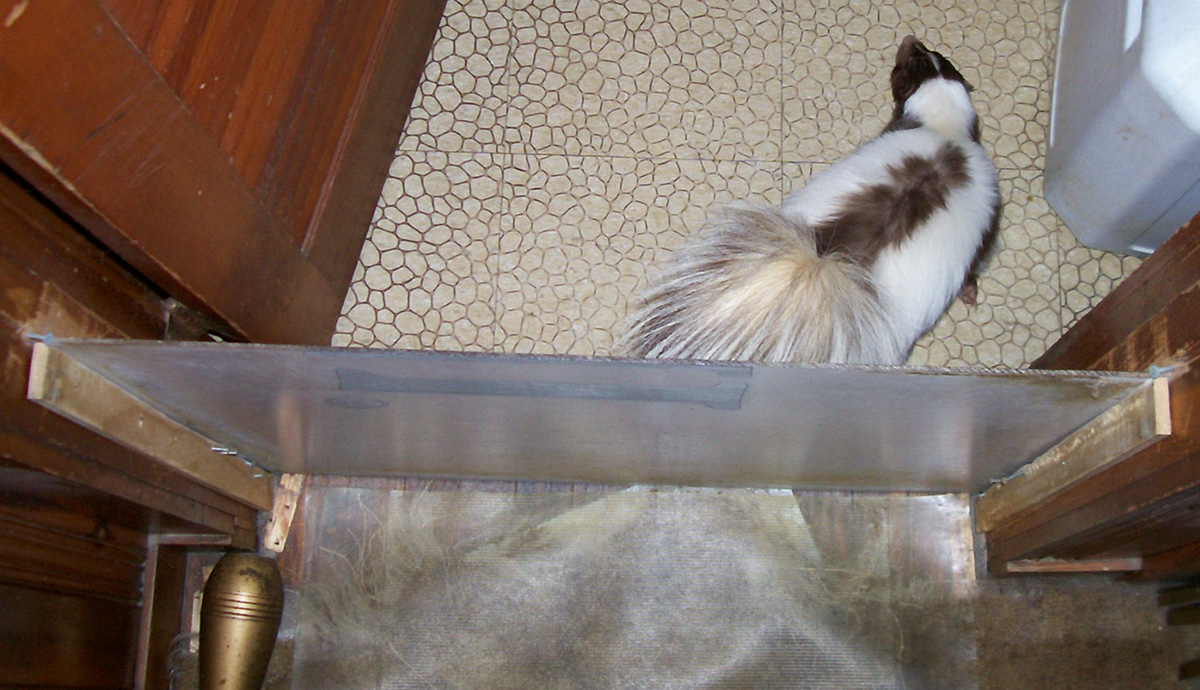 |
We cut two foot high Plexiglas sheets and slide between two pieces of wood nailed to the door jam, additional nails at the top prevent your skunk from pushing up the gate. Notice the plastic underneath, skunks may dig up the carpet by the door to get to the other side, plastic carpet runner, or even another piece of Plexiglas. |
To avoid any danger of a skunk trying to flatten out and slip under some doors.
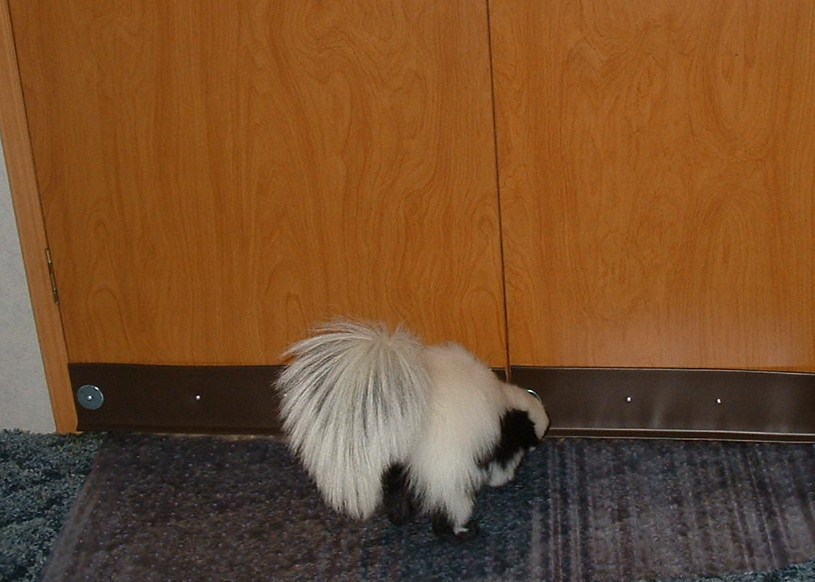 |
Use soft vinyl pieces (no sharp edges) and secured them to the doors with screws using large washers. |
| Photo by Carlene Ridenour |
Commercial pet gates, although costly, can be a better alternative - the gate can be opened as necessary for human and/or skunk passage.
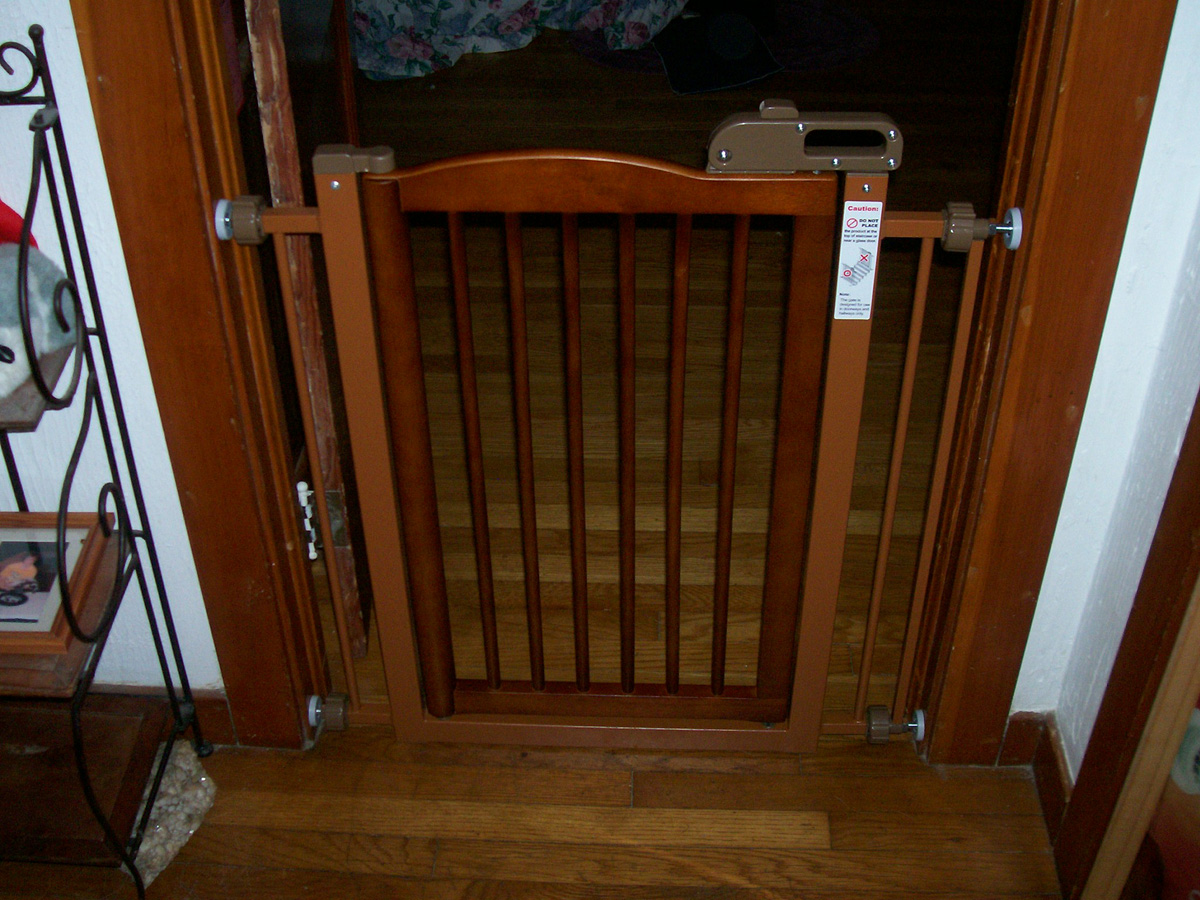 |
This pet gate is sturdy and almost impossible for skunks to climb over, note that some smaller skunks may be able to get thier head through the bars which could lead to problems. |
Have a fecal test done as soon as possible!. Make sure young kits are checked for coccidia and other protozoans as well as other parasites. Coccidiosis has been the cause of several deaths of skunk kits in recent years.
It is common for skunks to NOT test positive for roundworms. Worming is always recommended when getting a skunk. Follow the directions on the wormer for proper dosage and treatment regimen.
Do NOT de-claw a skunk unless some medical condition absolutely requires this procedure. Skunks use their paws and claws to hold food and the claws also help them balance and aid their ability to run.
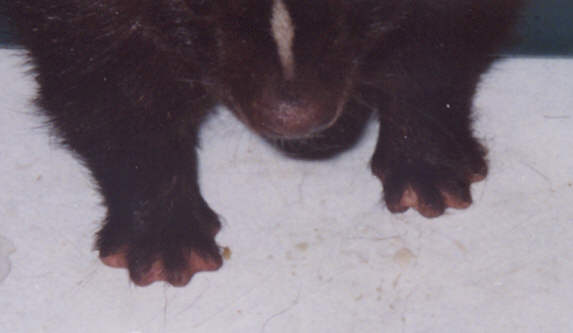 |
This skunk was de-clawed. He has trouble holding food, and he also has trouble walking on tile floors and using stairs. |
Every skunk loves to dig. They will dig at corners, closed doors, furniture, etc. They can find spots on carpet where food or drinks have been spilled and try to dig up the food they smell there. Linoleum and floor tile can be dug up. Ceramic tile isn't even completely safe, skunks have dug out the grout then ripped up the tiles.
Plastic carpet runners can be used over areas where the skunks want to dig. We've used 1/8 inch plexi-glass cut to fit in doorways to prevent the skunks from digging at the floor and carpet there.
They will also dig potted plants out, possibly eating parts of the plant and/or roots. Some houseplants are very toxic to skunks and other animals.
Skunks can damage furniture, wall-coverings, doors, wood trim, plastic, almost anything.
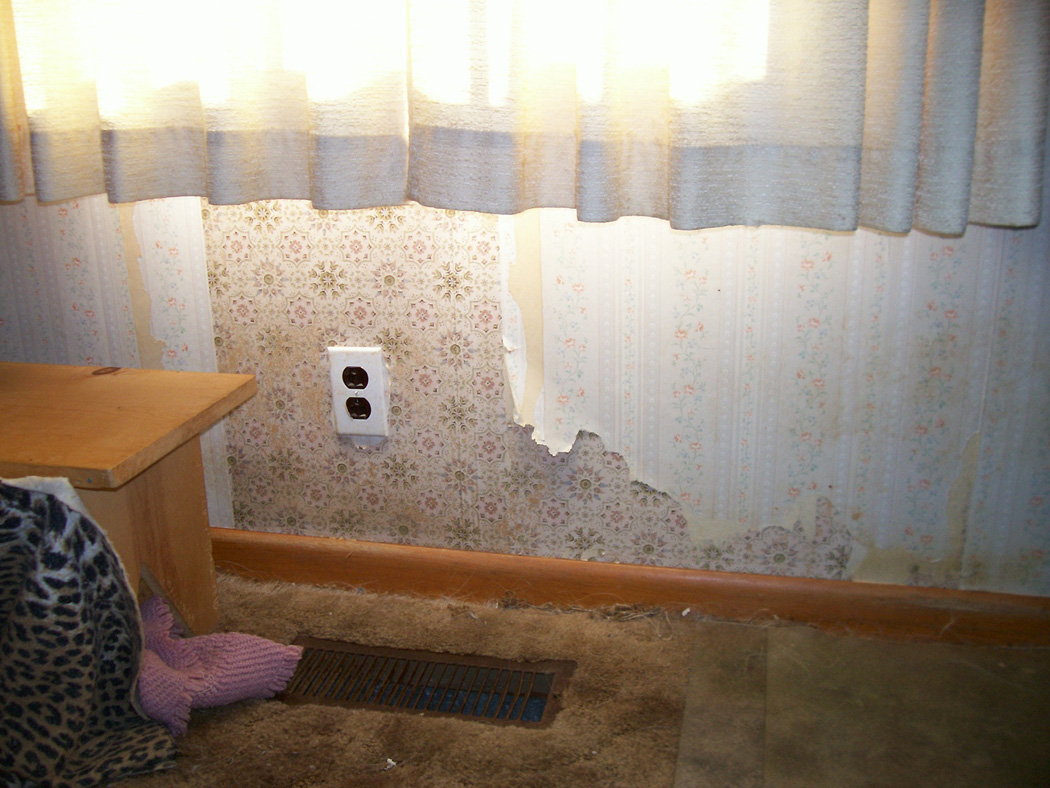 |
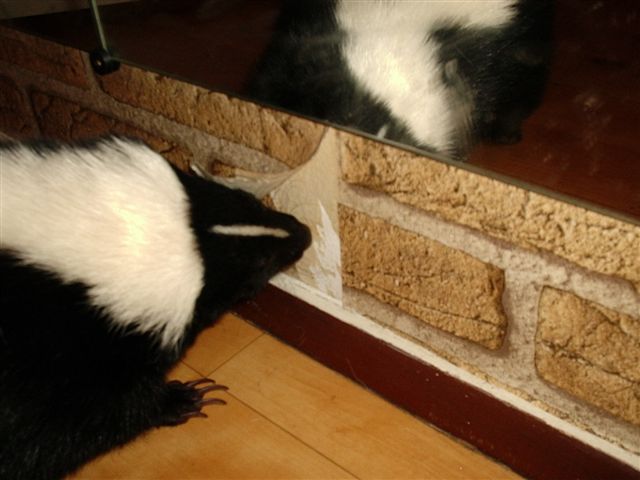 |
| Photo by Hennie Weidema |
They will unplug appliances, get into cupboards and push the contents out on the floor, wedge themselves into the tiniest spots, climb into/onto anything, and will steal away with anything soft for a bed or litter box filler.
Skunks can be toe nippers, especially when they are young. You can deter this by wearing shoes or slippers. Bitter Apple and other chew deterrent sprays may also be used; it is best to use a natural product.
This picture shows a common skunk invitation to play:
 |
Skunks have sharp teeth, the canine teeth can slash and puncture skin. Even young skunks can inflict severe bites. Older skunks can bite hard enough to break fingers or toes. You must train your skunk that biting is not proper. |
| Photo by Linda Lusby |
Most skunks go through a biting stage and must be trained not to bite. Spay/neuter will not ensure that the skunk will stop biting. Some skunks will bite at any time for no reason. You must break them from biting or they will get worse. Consistantly scolding and using time-outs will typically work within a short time.
Please make your family full aware that if your pet skunk bites and they need medical attention, doctors and hospital staff are required to report bites by exotic pets to the local health department. This may lead to your skunk being seized and killed to be tested for rabies. Never let anyone touch/pet your skunk; if your skunk bites someone, and it is reported, your skunk will be taken, killed, and tested for rabies. There is no quarantine period. Do not even joke about being bitten by your pet skunk; if someone is eavesdropping they can still report it!
Litter pans used could be square or corner ferret pans, or a covered kitty pan with the opening cut low to the ground.Make sure you have a litter pan in each room, skunks will not always use the same litter pan.
These pictures show cutting a cat litter box:
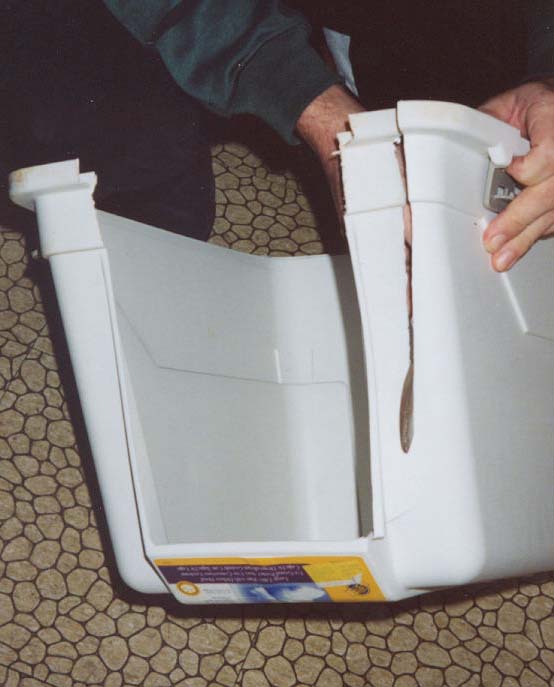 |
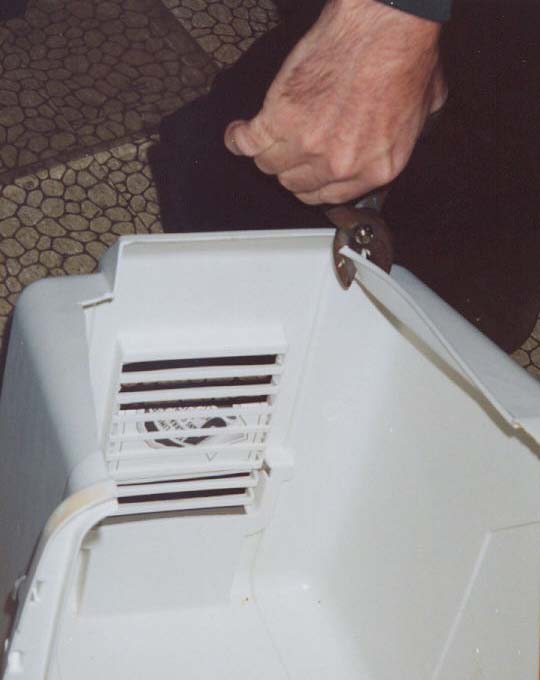 |
| A. Make the opening wider | B. Cut lower to the ground |
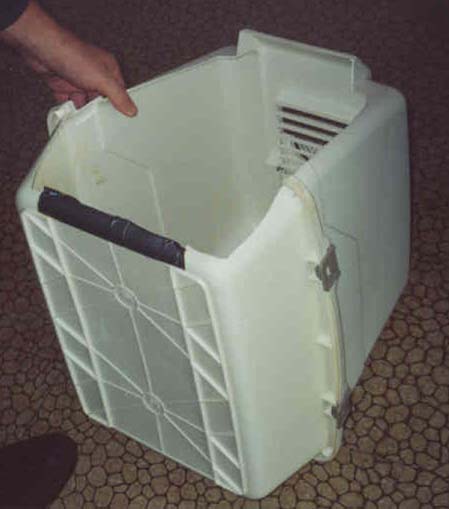 |
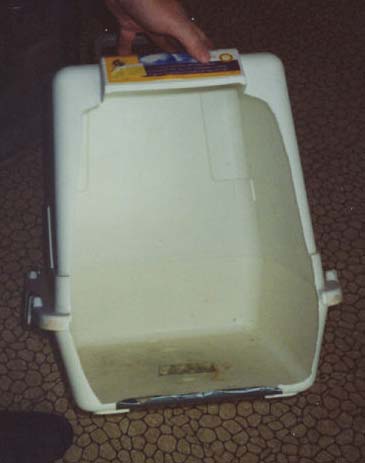 |
| C. Tape up any breaks or rough edges | D. The finished product |
Use wood pellets, recycled paper cat litter, unscented cat litter, or just sheets of newspaper in the pans. Some skunks will not use a litter pan if it has not been cleaned, clean the pans often, especially when training.
Potty Training - Begin training young skunks to use a litter box/pan as soon as the skunk arrives. Skunks will usually use a corner or elsewhere. Take time to notice the place the skunk want to use. Then place the litter pans in the skunk's chosen spot. They may learn to go in the pan, not on the floor. To aid in training cut puppy training pads into 2-inch squares and put into the litter box. You can use plain newspaper in boxes. Pans could be square or corner ferret pans, or a covered kitty pan with opening cut low to the ground.
Please note that some skunks may sometimes use or never use a litter box.
Please note that some skunks may eat the litter and get sick. Take it away, use flat newspaper.
Please note that one skunk will need a litter box per every room they are allowed to visit.
Skunks will wipe their rear on the floor, carpet, etc., after using the litter box; try putting pieces of old towel or blanket material outside the pans for them to use.
Skunks may not use the litter pan all of the time. Skunks will purposely forget to go in a litter box, especially when excited or mad. If your skunk is mad at you don't be surprised to discover unpleasant gifts in the middle of the floor, on your favorite chair, or at your bedroom door.
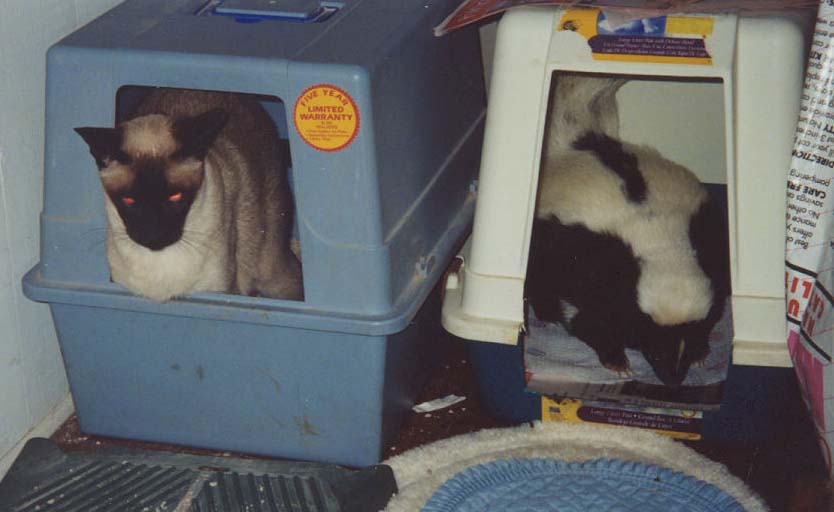 |
Some skunks like a covered litter box. Notice the skunk pan (on the right) is cut low. |
| Litter Boxes | |
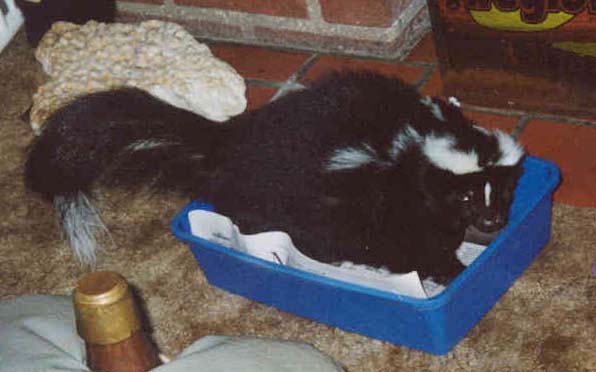 |
Some skunks prefer litter pans. |
| Litter Pan | |
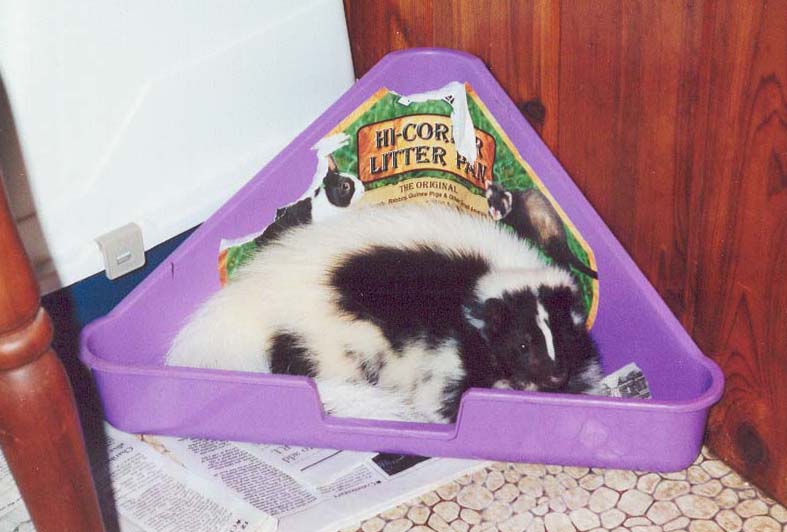 |
Some skunks don't use a litter pan as intended. |
| Litter Pan |
Some skunks may not use a litter box. Some will go anywhere, not just in a corner. You can try a large flat (plastic) tray or the drip tray from a dish strainer covered with newspaper.
Skunks like to have a soft, comfortable, bed to curl up in. Pick up any clothes, coats, socks, etc., you want to keep or your skunk will gladly take these things for its den.
Old baby blankets, old clothes, old sleeping bags can be recycled or bought at thrift stores for very little.
Skunks often rub their cheeks against hard objects, corners, cages, furniture, etc. Rocks or common red bricks are favorites.
We suggest getting quartz or other hard, non-porous, rocks as the oils rubbed onto the stone should be cleaned off regularly.
Some skunks are affected by natural instincts during the breeding season, January through March. Males and females can be very territorial, and can be aggressive toward other animals. Some skunks will urinate and defecate in unusual places, some will find out of the way places to hide and sleep, some skunks are less tolerant at play-time.
Be mindful of leaving male and female skunks together, especially during breeding season. Skunks have been known to fight and can cause severe injuries. Unfortunate occurrences while the owners were out have led to death or wounds that resulted in having skunks put down.
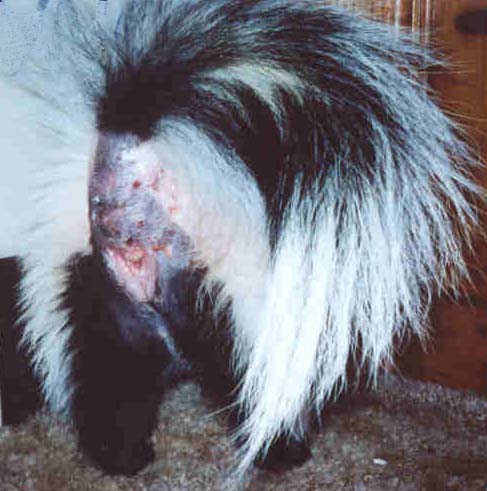 |
| Bite Wounds |
To be fair, some skunks are less aggressive to opposite sex skunks during breeding season.
Some skunks pace, especially during the winter breeding season and before meal times. They can pace only a few feet, or walk an entire room, repeatedly for hours on end. Nothing seems to deter them. Some skunks will calm down and stop pacing if given Rescue Remedy Liquid, just a drop should do.
Skunks can be finicky eaters. Sometimes they will eat things they wouldn't touch before, and sometimes they will not eat something they liked yesterday. The best thing to do is provide a variety of foods so they don't get bored with the same thing. Don't over-do the variety, if you give them something "new" make sure there's something else in the bowl that they will surely eat.
Pet skunks should be fed daily. We recommend feeding young skunks up to five times per day for proper nutrition, and adults twice each day to maintain their activity levels (which improves overall health). You should never let your skunk go for more than a day without eating.
If your skunk is throwing-up bile (milky white digestive juices) you need to feed the skunk something as soon as possible. When skunks are active prior to normal feeding times their bodies expect food and they will produce bile, if they are not fed soon they will often expel the bile, this can cause them some discomfort if it happens often.
Skunks that are not fed properly will show signs of kidney failure, liver failure, and/or gastrointestinal problems.
Bathing can be done occasionally (like, before skunk shows). Most skunks tolerate swimming and playing in water. Use ferret shampoo or a non-medicated dog shampoo if they have a musky smell.
A good way to wash your skunk is to buy a sprayer hose that connects to the shower. Your skunk will be less scared than running the water from the fauset. Notice we have a rubber mat down so the skunk will not slip and a drain stop so your skunks nails will not get caught in the drainer.
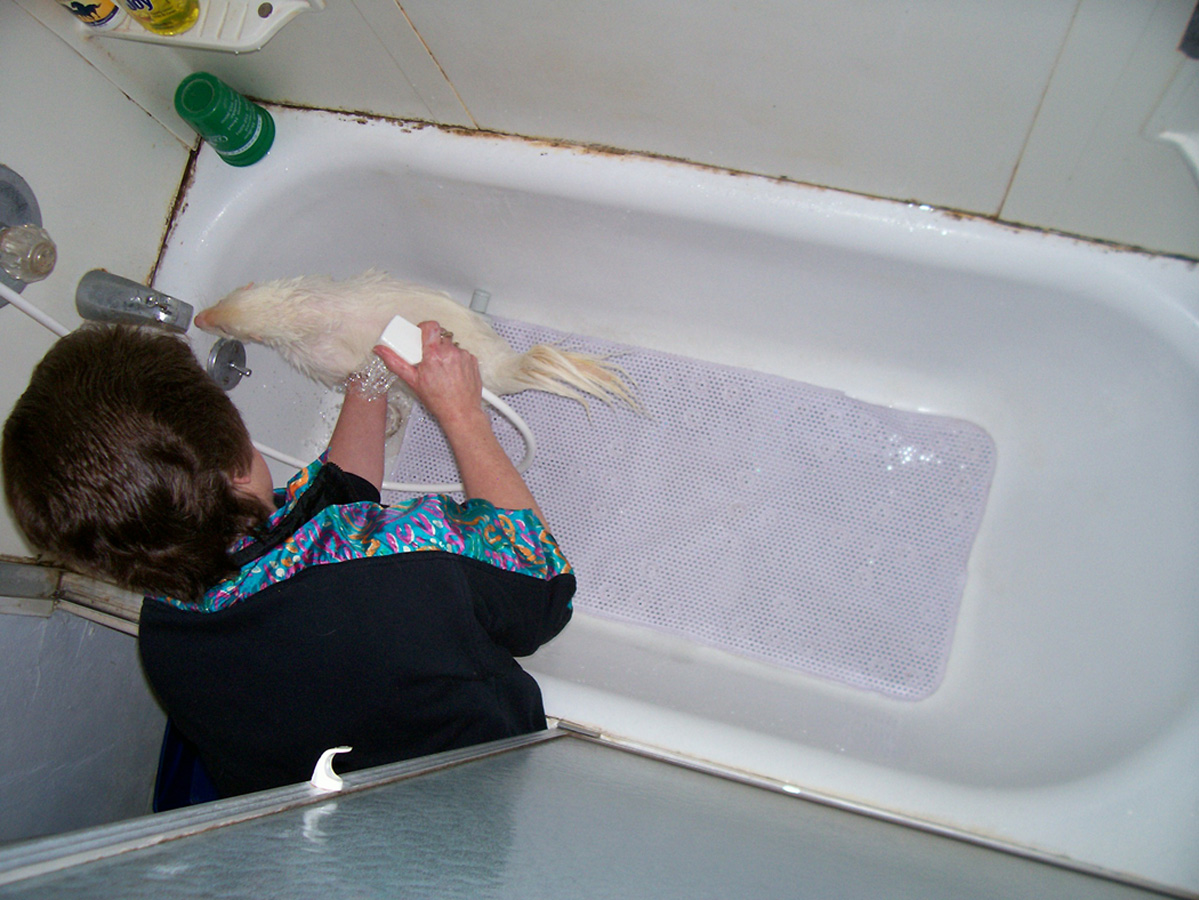 |
A good way to wash your skunk is to buy a spray hose that connects to the shower. Your skunk will be less scared than running the water from the faucet. Notice we have a rubber mat down so the skunk will not slip and a drain stop so your skunks nails will not get caught in the drain. |
| Bathing a skunk |
We bath our skunks with Ferret Glo shamoo.
To clean a skunks ears, depending on the amount of ear debris, you will need either a cotton swab, a soft damp wash cloth, or a commerical pet ear cleaning pads. Use water to moisten the swab or wash cloth, commercial pet products have safe ingredients in them.
Positioning will depend on how well your skunk deals with this, some skunks are not comfortable with getting their ears wet. Gently wipe the debris from the ear, do not go down into the ear canal. If there is debris that is seen in the ear canal, please see your vet.
Dental care is important in skunks, as with ourselves and other pets. Some skunks will use (dog) chew toys, or cloth or rope toys. Do not use rawhide or pressed bone products for skunks.
Some people brush their skunk's teeth. This is Rocket, one of the skunks we adopted out to a happy family:
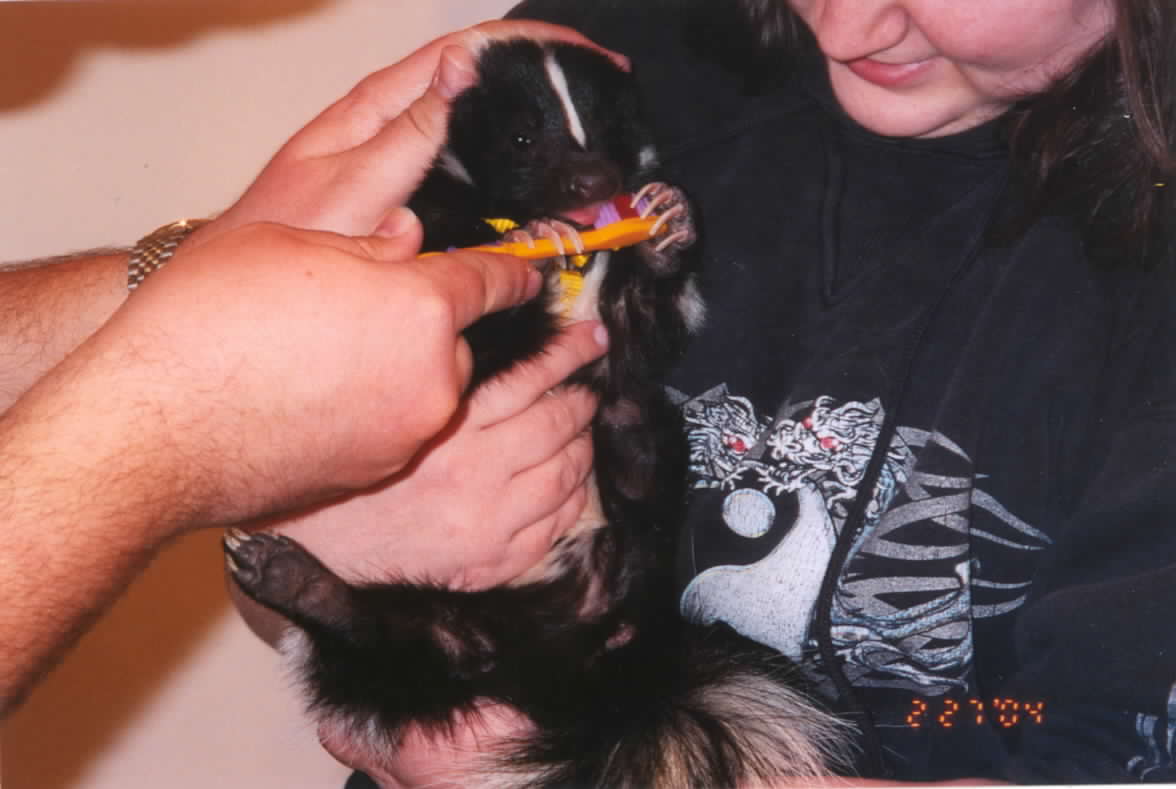 |
Brushing a skunk's teeth. |
| Photo by Robert and Megan Gump |
During the summer months we often take skunks out for exercise or exhibits. Skunks can become overheated in a short time, especially when being held, when in direct sunlight, or when there is no ventilation. We have found that using ice-packs can prevent unnecessary stress.
We freeze bottled water and commercial ice-packs, or put ice cubes into a watertight container, then wrap in a towel and place into the cage or carrier with the skunk. When holding or carrying a skunk for long periods we keep a small ice pack under or beside the skunk.
Always remember to have fresh water available to your skunk, especially during the summer months.
© 2001-2015 Skunk Haven™ Skunk Rescue, Shelter, and Education, Inc.
Revised 07/01/15 (SRS)
 |
||
| Previous | SkunkHaven.Net Index | Next |
|
|
Validate HTML 4.01 |